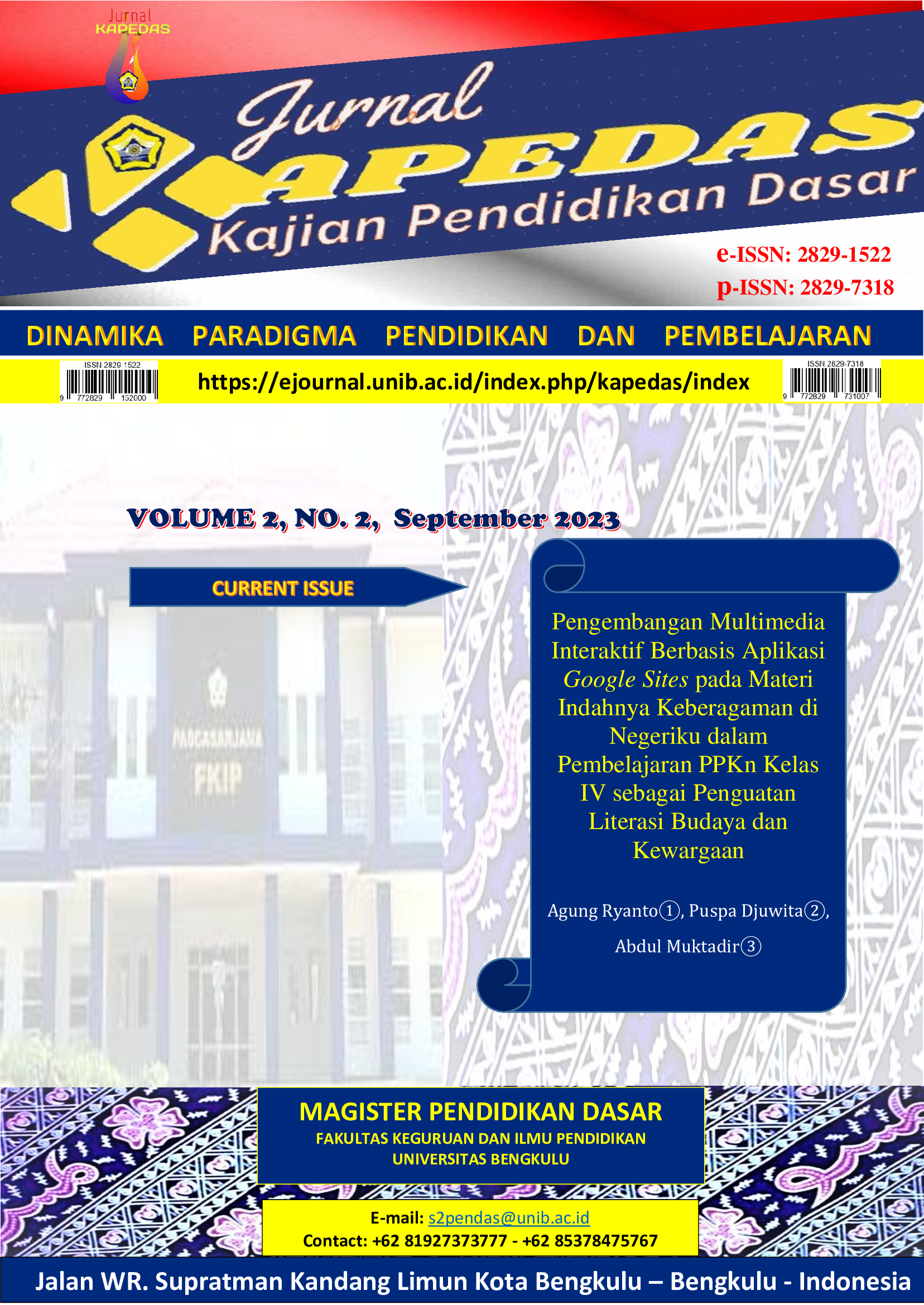Main Article Content
Abstract
The purpose of this research is to determine the influence of STEAM-based virtual reality media on Science Literacy in Science Education at the Elementary School level, specifically in terms of content, context, competence, and attitude. The research design used is a Quasi-Experimental or quasi-experimental study with a Pretest-Posttest Control Group design to examine the impact of using virtual reality media with a STEAM approach on content, context, competence, and science literacy attitude. Based on the research findings, it can be concluded that STEAM-based virtual reality media is suitable for use as teaching material in the 6th-grade Science curriculum, specifically on the topic of the solar system. The validation results show a percentage of 80% for content, 78% for language, and 86% for design. The research results indicate that in terms of content, the average learning outcomes of the experimental group were 38.04, while the control group had an average of 20.23, as evidenced by the Mann-Whitney test for science literacy. In terms of context, the average learning outcomes of the experimental group were 36.69, compared to 21.40 for the control group. Regarding competence, the inferential test for science literacy showed a mean rank of 39.79 for the experimental group and 18.73 for the control group. As for attitude, the inferential test results revealed a mean rank of 89.13 for the experimental group and 82.67 for the control group. Thus, it can be concluded that there is an influence of STEAM-based virtual reality media on the content, context, competence, and attitude aspects of Science Literacy in Science Education at the elementary school level.
Article Details
Copyright (c) 2023 Fadhli Omi Raharjo, Endang Widi Winarni, Irwan Koto

This work is licensed under a Creative Commons Attribution-ShareAlike 4.0 International License.

Karya ini dilisensikan di bawah Creative Commons Attribution-ShareAlike 4.0 International License .
References
- Abdullah, A. H. (2019). The Role of Project-Based Learning in Enhancing 21st Century Skills: A Review. Jurnal Pendidikan Modern, vol. 9, no. 12, halaman 560-573
- Acedo, C., & Hughes, C. 2014. Principles for learning and competences in the 21st-century curriculum.Prospects, 44(4), 503–525. DOI: 10.1007/s11125-014-9330-1
- Bahar, Y. N. (2014). Aplikasi Teknologi Virtual Reality Bagi Pelestarian Bangunan Arsitektur. Jurnal Desain Konstruksi, Volume 13, Nomor 2, Desember 2014
- Ifanova, P. J., Salima, S., Syahputra, M. E., Suria, P. A., & Ifanova, I. (2022). A Systematic literature review on implementation of virtual reality for learning. Procedia Computer Science. DOI: 10.1016/j.procs.2022.12.135
- Jones, L. R., Wheeler, G., & Centurino,V. A. (2015). TIMSS 2015 scienceframework. TIMSS, 29-59.
- Lederman, N.G., Lederman, J.S., & Antink, A. (2013). Nature of science and scientific inquiry as contexts for the learning of science and achievement of scientific literacy. International Journal of Education in Mathematics, Science and Technology, 1(3), 138-147.
- Mandal, Sharmistha (2013) Brief Introduction of Virtual Reality & its Challenges, International Journal of Scientific & Engineering Research, Volume 4, Issue 4, April-2013
- Muskania, R. T., Arifin Maksum, A., & Astra, I. M. (2023). STEM-PjBL learning incorporates local knowledge to improve science literacy. Cypriot Journal of Educational Sciences, 18(2), 522-532. https://doi.org/10.18844/cjes.v18i2.8791
- Obrist, M., Velasco, C., Vi, C., Ranasinghe, N., Israr, A., Cheok, A. D., Spence, C. and Gopalakrishnakone, P. (2016). Sensing the future of HCI: Touch, taste, and smell user interfaces. Interactions, 23(5), pp. 40-49. doi:10.1145/2973568
- OECD. (2017). PISA 2015 Assessment and Analytical Framework: Science, Reading, Mathematic, Financial Literacy and Collaborative Problem Solving, revised edition, PISA, OECD Publishing, Paris. http://dx.doi.org/10.1787/9789264281820-en.
- OECD. (2019). PISA 2018 Assessment and Analytical Framework, PISA, OECD Publishing, Paris, https://doi.org/10.1787/b25efab8-en.
- Sadiman, A. S. 2014. Media Pendidikan, Pengertian, Pengembangan dan Pemanfaatannya. Jakarta: PT Raja Grafindo Persada.
- Winarni, E.W. (2018). Teori dan Praktik Penelitian Kuantitatif Kualitatif. Jakarta: Bumi Aksara
- Winarni, E. W. (2018). Pendekatan Ilmiah Dalam Pembelajaran Kreatif dan Inovatif. Bengkulu: FKIP UNIB.
- Yakman, G. (2008) STEAM Education: an overview of creating a model of integrative education. Virginia Polytechnic and State University.
References
Abdullah, A. H. (2019). The Role of Project-Based Learning in Enhancing 21st Century Skills: A Review. Jurnal Pendidikan Modern, vol. 9, no. 12, halaman 560-573
Acedo, C., & Hughes, C. 2014. Principles for learning and competences in the 21st-century curriculum.Prospects, 44(4), 503–525. DOI: 10.1007/s11125-014-9330-1
Bahar, Y. N. (2014). Aplikasi Teknologi Virtual Reality Bagi Pelestarian Bangunan Arsitektur. Jurnal Desain Konstruksi, Volume 13, Nomor 2, Desember 2014
Ifanova, P. J., Salima, S., Syahputra, M. E., Suria, P. A., & Ifanova, I. (2022). A Systematic literature review on implementation of virtual reality for learning. Procedia Computer Science. DOI: 10.1016/j.procs.2022.12.135
Jones, L. R., Wheeler, G., & Centurino,V. A. (2015). TIMSS 2015 scienceframework. TIMSS, 29-59.
Lederman, N.G., Lederman, J.S., & Antink, A. (2013). Nature of science and scientific inquiry as contexts for the learning of science and achievement of scientific literacy. International Journal of Education in Mathematics, Science and Technology, 1(3), 138-147.
Mandal, Sharmistha (2013) Brief Introduction of Virtual Reality & its Challenges, International Journal of Scientific & Engineering Research, Volume 4, Issue 4, April-2013
Muskania, R. T., Arifin Maksum, A., & Astra, I. M. (2023). STEM-PjBL learning incorporates local knowledge to improve science literacy. Cypriot Journal of Educational Sciences, 18(2), 522-532. https://doi.org/10.18844/cjes.v18i2.8791
Obrist, M., Velasco, C., Vi, C., Ranasinghe, N., Israr, A., Cheok, A. D., Spence, C. and Gopalakrishnakone, P. (2016). Sensing the future of HCI: Touch, taste, and smell user interfaces. Interactions, 23(5), pp. 40-49. doi:10.1145/2973568
OECD. (2017). PISA 2015 Assessment and Analytical Framework: Science, Reading, Mathematic, Financial Literacy and Collaborative Problem Solving, revised edition, PISA, OECD Publishing, Paris. http://dx.doi.org/10.1787/9789264281820-en.
OECD. (2019). PISA 2018 Assessment and Analytical Framework, PISA, OECD Publishing, Paris, https://doi.org/10.1787/b25efab8-en.
Sadiman, A. S. 2014. Media Pendidikan, Pengertian, Pengembangan dan Pemanfaatannya. Jakarta: PT Raja Grafindo Persada.
Winarni, E.W. (2018). Teori dan Praktik Penelitian Kuantitatif Kualitatif. Jakarta: Bumi Aksara
Winarni, E. W. (2018). Pendekatan Ilmiah Dalam Pembelajaran Kreatif dan Inovatif. Bengkulu: FKIP UNIB.
Yakman, G. (2008) STEAM Education: an overview of creating a model of integrative education. Virginia Polytechnic and State University.
